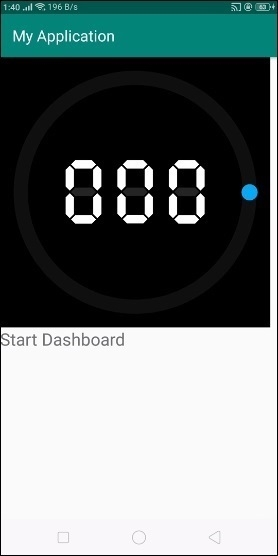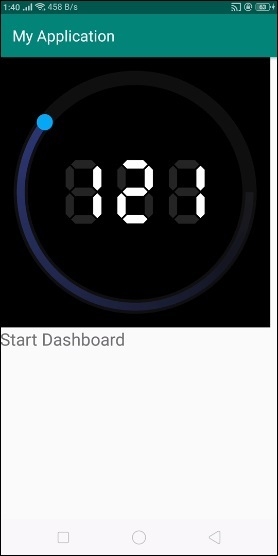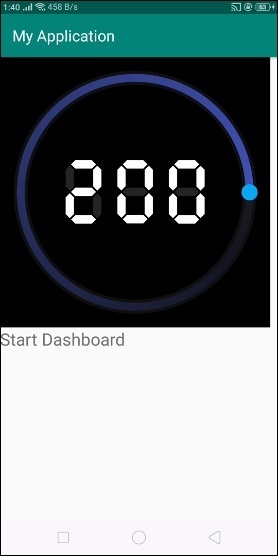如何在Android中建立DigitalSpeedDashboard?
此示例演示瞭如何在Android中建立DigitalSpeedDashboard。
步驟1 - 在Android Studio中建立一個新專案,轉到檔案⇒新建專案,並填寫所有必需的詳細資訊以建立新專案。
步驟2 - 開啟build.gradle並新增如下所示的庫依賴項:
apply plugin: 'com.android.application'
android {
compileSdkVersion 28
defaultConfig {
applicationId "com.example.andy.myapplication"
minSdkVersion 19
targetSdkVersion 28
versionCode 1
versionName "1.0"
testInstrumentationRunner "android.support.test.runner.AndroidJUnitRunner"
}
configurations {
cleanedAnnotations
compile.exclude group: 'org.jetbrains' , module:'annotations'
}
buildTypes {
release {
minifyEnabled false
proguardFiles getDefaultProguardFile('proguard-android.txt'), 'proguard-rules.pro'
}
}
}
dependencies {
implementation fileTree(dir: 'libs', include: ['*.jar'])
implementation 'com.android.support:appcompat-v7:28.0.0'
implementation 'com.github.ngallazzi:DigitalSpeedDashboard:master-SNAPSHOT'
implementation 'com.android.support.constraint:constraint-layout:1.1.3'
testImplementation 'junit:junit:4.12'
androidTestImplementation 'com.android.support.test:runner:1.0.2'
androidTestImplementation 'com.android.support.test.espresso:espresso-core:3.0.2'
implementation 'org.jetbrains:annotations-java5:15.0'
}現在開啟build.gradle(application)並新增以下幾行:
// Top-level build file where you can add configuration options common to all sub-projects/modules.
buildscript {
repositories {
google()
jcenter()
}
dependencies {
classpath 'com.android.tools.build:gradle:3.2.1'
// NOTE: Do not place your application dependencies here; they belong
// in the individual module build.gradle files
}
}
allprojects {
repositories {
google()
jcenter()
maven { url 'https://jitpack.io' }
}
}
task clean(type: Delete) {
delete rootProject.buildDir
}步驟3 - 將以下程式碼新增到res/layout/activity_main.xml。
<?xml version = "1.0" encoding = "utf-8"?>
<LinearLayout xmlns:android = "http://schemas.android.com/apk/res/android"
xmlns:app = "http://schemas.android.com/apk/res-auto"
xmlns:tools = "http://schemas.android.com/tools"
android:layout_width = "match_parent"
android:layout_height = "match_parent"
android:orientation = "vertical"
tools:context = ".MainActivity">
<com.ngallazzi.speedandrpmdashboard.DigitalSpeedDashboard
android:id = "@+id/srDashboard"
android:layout_width = "350dp"
android:layout_height = "350dp"
app:idleColor = "#35ABABAB"
android:background = "#000000"
app:speedColor = "#FFFFFF"/>
<TextView
android:id = "@+id/text"
android:layout_width = "wrap_content"
android:layout_height = "wrap_content"
android:text = "Start Dashboard"
android:textSize = "25sp" />
</LinearLayout>在上面的程式碼中,我們使用了TextView和digitalSpeedDashboard。當用戶點選TextView時,它將啟動digitalSpeedDashboard。
步驟4 - 將以下程式碼新增到src/MainActivity.java
package com.example.andy.myapplication;
import android.os.Bundle;
import android.support.v7.app.AppCompatActivity;
import android.view.View;
import android.widget.TextView;
import com.ngallazzi.speedandrpmdashboard.DigitalSpeedDashboard;
public class MainActivity extends AppCompatActivity {
TextView text;
int speed;
boolean time;
DigitalSpeedDashboard digitalSpeedDashboard;
@Override
protected void onCreate(Bundle savedInstanceState) {
super.onCreate(savedInstanceState);
setContentView(R.layout.activity_main);
text = findViewById(R.id.text);
digitalSpeedDashboard = findViewById(R.id.srDashboard);
digitalSpeedDashboard.setMaxSpeed(200);
text.setOnClickListener(new View.OnClickListener() {
@Override
public void onClick(View v) {
new Thread(new Runnable() {
@Override
public void run() {
time = true;
while (time) {
speed++;
digitalSpeedDashboard.setSpeed(speed);
try {
Thread.sleep(10);
} catch (InterruptedException e) {
e.printStackTrace();
}
if (speed == 200) {
time = false;
speed = 0;
}
}
}
}).start();
}
});
}
}讓我們嘗試執行您的應用程式。我假設您已將您的實際Android移動裝置連線到您的計算機。要從Android Studio執行應用程式,請開啟專案的Activity檔案之一,然後單擊工具欄中的執行![]() 圖示。選擇您的移動裝置作為選項,然後檢查您的移動裝置,它將顯示您的預設螢幕:
圖示。選擇您的移動裝置作為選項,然後檢查您的移動裝置,它將顯示您的預設螢幕:

上面的螢幕是初始螢幕,當用戶點選TextView時,它將啟動數字儀表盤,最終達到200並停止數字儀表盤,如下所示:


點選此處下載專案程式碼

廣告

 資料結構
資料結構 網路
網路 關係資料庫管理系統 (RDBMS)
關係資料庫管理系統 (RDBMS) 作業系統
作業系統 Java
Java iOS
iOS HTML
HTML CSS
CSS Android
Android Python
Python C語言程式設計
C語言程式設計 C++
C++ C#
C# MongoDB
MongoDB MySQL
MySQL Javascript
Javascript PHP
PHP